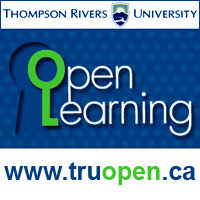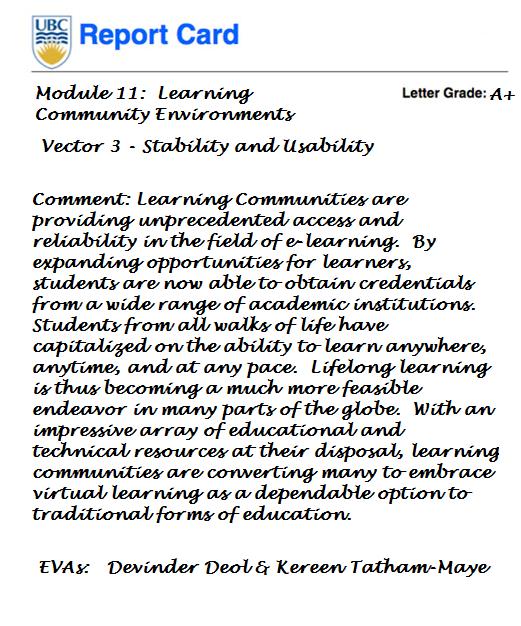Course:ETEC522/2010ST1/LearningCommunityEnvironments/Vector 3-Stability and Usability
Prescribed Learning Outcome
By the end of this vector, ETEC522 participants should be able to:
1. discuss key issues impacting the stability and usability of online learning communities
Vector 3 - Stability and Usability

Consortia involve more than two institutions in a collaborative arrangement. Online communities must continually struggle with the problems and possibilities of their own capacities to become and remain communities. Some of the issues to consider when planning to create an online community are:
1. Audience Analysis: Decide on the target audience and its characteristics. Consider the learners' experiences in using the Internet. Identify the learners' knowledge level.
2. Limitations: Ensure that all members of the target audience have access to the Internet, microcomputers and related technologies. Otherwise, the community must make provision to provide access to participants without access to technology.
3. Task Analysis: Determine the task that users will perform while using the tools available and participating in the community. Identify pre-requisites that users must possess before qualifying to participate in the community.
4. Evaluation: The developers of the learning community must ensure that the value of participants' contribution can be judged. This will ensure that community goals are addressed.
OpenSchool BC & Reliable Access
Sean Procyshyn, Senior Systems Analyst with OpenSchool BC feels that the days of schools going it alone with respect to the delivery of online educational programs are numbered. He states that there's no question that subscription to a learning community or consortium is far less expensive and provides much more reliable service than the implementation and maintenance of a stand-alone system.
The OpenSchool BC Online Consortium (OC) is a membership-driven service that functions as a cost-recovery operation. OC membership is made up of school districts and schools, operating on a fee per usage basis. OC members save on equipment, maintenance and technician costs.
Currently Open School BC uses as an array of Sun Solaris servers and offers the following technical support services: 
- Server room configuration to ensure appropriate power requirements, cooling and security
- Oracle and MySQL Database installation, support, and licensing
- SUN Service Agreements
- Clustered Environments for Failover ability
- Backups – Daily and Weekly backups with offsite storage (critical for any school-we know from painful personal experience)
- A full complement of server hardware and processes including redundant disaster recovery servers
OSBC employs five full time technicians. In the event of system failure, staff are available on call nearly 24/7. Since students often access online content at unusual hours, it is critical that schools have a failsafe flow of content. Procyshyn (2010) estimates that OSBC servers are accessible over 99% of the time. Its unlikely that a single school or school district could dedicate this number of support staff and have such infrequent down times. Hosting a consortium with 22,000 student-users triggers some significant economies of scale that permit a very reliable level of service for end-users.
British Columbia Open University (now Thompson Rivers University Open Learning)


Since 1979, British Columbia's Open University, BCOU, has been making a difference in the lives of thousands of students. It is comprised of three research universities (Simon Fraser University, the University of British Columbia, and the University of Victoria) plus the Open Learning Agency (OLA) in British Columbia. Courses and programs are also offered in co-operation with other educational institutions, professional associations, workplaces and community organizations.
As of April 1, 2005, BCOU has been operated by Thompson Rivers University, located in Kamloops, BC. BCOU is now known as Thompson Rivers University Open Learning or TRU-OL. It is a highly successful consortium that provides impressive access to distance education courses at all of the leading universities in British Columbia.
TRU-OL has become a national leader in distance learning. Career and educational goals are obtainable for anyone through accessible and varied courses that can be taken anytime and at an individually-determined pace. With over 400 individual courses and more than 57 programs available for completion by distance and online learning, students can take a variety of programs such as: adult secondary school completion; certificates and diplomas, including advanced and post-baccalaureate; associate degrees; and bachelor's degrees.


Some features of this consortium include:
- An open access program, enabling students to complete a full degree at a distance.
- Courses can be combined from different universities, regardless of prior qualifications, or by transferring approved programs that are taken at a distance.
- Students who complete a degree this way are awarded a degree from TRU-OL, which is recognized by government and the Association of Universities and Colleges of Canada. There have been over eleven hundred graduates through this program.
- Students can easily transfer credits from one university to another.
- There is joint planning to avoid duplication of courses. The universities and TRU-OL meet regularly to exchange program information and to avoid duplication of distance education programs as far as possible.
- There's joint publicity and marketing of distance education courses and programs at a university level. TRU-OL publishes a single calendar that list all the courses and programs available by distance in the province at a university level.
- TRU-OL provides free student counselling and advisory services for anyone interested in taking a university level distance education course.
- TRU-OL operates a 'credit bank' where students with qualifications from outside the province can have these accredited for use in the province. (TRU-OL 2010)
Additionally, TRU-OL courses use a wide range of print, video and audio media as well as computer technology in their delivery of subject material to students. TRU-OL is a leader in the use of computer conferencing in the delivery of education and online learning. This allows students around the province to receive tutoring online and to participate in discussions and debates.
Discussion
Case Studies (respond to one or more of the questions below marked by a blue bullet in Wordpress. Thanks :-))
In 2009, over 16,000 students a year took courses through Thompson Rivers University-Open Learning (TRU-OL) toward 52 degree, diploma and certificate programs. This included 220 Thompson Rivers U. distance courses and another 200 delivered through consortium institutions (mainly UBC, SFU & UVic). TRU-OL encourages students to take online post-secondary courses through a host of participating institutions.
- What are the benefits of taking courses at multiple institutions? Have you considered taking courses from an institution other than UBC and using them towards your MET degree?
The Impact of greater Choice in Education. In September, 2009 the funding model for Secondary (high school) education changed in British Columbia. High schools are now funded 'per course.' Previously, schools received a lump sum of approximately $6,000 for each 'full time' student registered at the school. Now, brick-and-mortar schools receive $800 for each course and students have the right to take courses at more than one school, including online schools. This policy change has fueled dramatic growth in the number of students taking courses through online providers. During the 2009/2010 school year, approximately 10% of all BC K-12 students, and 20% of those in grades 10, 11, 12 registered for an online Distributed Learning course (Winkelmans, 2010).
- Is it likely that your children or the children you know will take all of their courses at a single Elementary or Secondary school?
- Like it or not, with the move to 'per course' funding and other similar initiatives in Canada and the U.S., the element of competition is steadily being introduced into public schooling. The hidden message from government is clear: offer high quality programs or watch as your students migrate to other brick-and-mortar or online schools. All schools are wanting to attract students to maintain their funding base and avoid layoffs. Do you feel that the element of competition will enhance or detract from the delivery of quality education?
References
Bates, Tony 2001 National strategies for e-learning in post-secondary education and training Paris: UNESCO/International Institute for Educational Planning. Retrieved 21 June 2010 from http://unesdoc.unesco.org/images/0012/001262/126230e.pdf
Procyshyn, Sean. Senior Systems Analyst, OpenSchool BC (2010). Personal Interview. 21 July 2010.
Thompson Rivers University Open Learning (TRU-OL 2010). About TRU Open Learning. Retrieved 14 July 2010 from http://www.tru.ca/distance/about.html.
Winkelmans, T. (2010). Ministry of Education: eLearning Programs Update, April 2010. Virtual School Society Spring Conference: 21st Century Learning & Sharing, Engaging for Success. 23 April 2010. Retrieved 2 June 2010 from http://knowevents.ca/course/view.php?id=34
Vector Report Card
Nagivation
Return to Vector 2: Leading Solution Providers
Continue to Vector 4: Total Cost of Ownership (TCO)
Return to Course:ETEC522/2010ST1/LearningCommunityEnvironments
